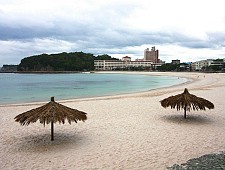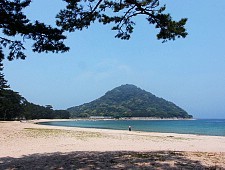Posted by
hasmik 年月日 Jun 28, 2015 in
日本,
旅行Japan is a long, thin island country with the Pacific Ocean on one side and the Sea of Japan and East China Sea on the other. The length of the country results in an extensive coastline with lots of beaches. It also means that the climate and swimming season differ quite a bit from south to north. The best beaches for sunbathing and swimming are found in Okinawa to the south, but nice beaches exist in other regions, too.
Beaches often provide basic facilities such as toilets, changing rooms and showers. During the warmer months, swimming, snorkeling, surfing and sunbathing are popular beach activities. At the more popular beaches, lifeguards are present, and rental shops and temporary beach huts open for business, providing beachgoers with more showers, changing rooms, shaded rest areas, food and drinks.
Swimmers should be aware that strong currents and poisonous marine life, such as jellyfish, are hazards at some beaches, and inform themselves with up-to-date information before entering the water. Beachgoers should also keep the beaches clean and take their trash away with them. Many beaches do not provide garbage cans. Certain beaches may have additional rules posted, such as noise restrictions after sunset or – in rare cases – prohibitions on alcohol. Nudity is generally not allowed in public, and nudist beaches virtually inexistent.
Below is a selection of some areas where tourists can find beaches in Japan:
Okinawa
Subtropical Okinawa Prefecture is famous for its white sand beaches, turquoise waters and warm climate with temperatures barely falling below 15 degrees in winter and beaches that are open all year round. The best time to go swimming is usually from around late May until October. When using the beaches, always beware of strong currents that can pull you out to sea and poisonous creatures such as Habu Jellyfish, a type of box jellyfish, that are most prevalent from June to October.
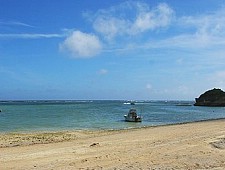 |
| Okinawa Prefecture |
| Okinawa Main Island (more details) |
| Okinawa Main Island has many white sand beaches, of which some are owned by the large resort hotels located right by the beach. Resort beaches are open to everyone, although some charge for beach access. While most of the beaches are for swimming and sunbathing, others offer snorkeling opportunities. See our separate page about beaches on Okinawa Main Island for more details. |
|
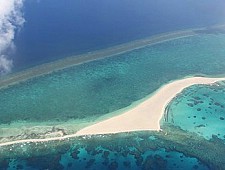 |
| Okinawa Prefecture |
| Kume Island (more details) |
| There are three main beaches on Kume Island that offer swimming and snorkeling opportunities. Not far away is a seven kilometer long white sand bar known as Hatenohama Beach (shown in image), which can only be accessed by boat tours. |
|
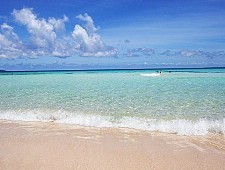 |
| Okinawa Prefecture |
| Miyako Island (more details) |
| Miyako Island is the fourth largest island in Okinawa Prefecture, and is known for having some of the best beaches in Japan and as a great destination for snorkeling and diving. There are picturesque sand beaches for swimming and sunbathing, and coral reefs for snorkeling. |
|
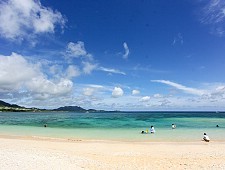 |
| Okinawa Prefecture |
| Ishigaki Island (more details) |
| Ishigaki Island offers several nice beaches and good snorkeling in the coral reefs which surround nearly every beach on the island. Kabira Bay, considered Ishigaki Island’s most scenic view, does not allow swimming or snorkeling but there are glass bottom boat rides available for those who want to explore the bay. |
|
Around Tokyo
Despite Tokyo‘s image as a bustling metropolis, there are beaches not far from the city. In the summer, beaches along the Shonan Coast and Miura Peninsula in Kanagawa Prefecture are very popular. The Izu Peninsula is often considered to have the best beaches and snorkeling near Tokyo, while the Boso Peninsula in Chiba Prefecture is particularly popular amongst surfers. The Izu Island chain south of Tokyo, including Izu Oshima, offers more beaches. The official swimming season around Tokyo typically lasts from mid July through August, but air and water temperatures are often warm enough before July and into September.
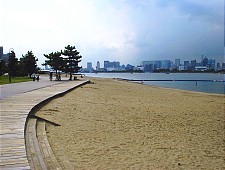 |
| Tokyo |
| Odaiba (more details) |
| Odaiba has an 800-meter long, man-made beach near the Decks shopping mall, with public facilities like showers and toilets. Swimming is not allowed at the beach, and most people go there to enjoy the sun and sand, and participate in activities like beach volleyball. Rainbow Bridge and the skyscrapers of Tokyo are visible from the beach, making it a nice spot to see sunsets. |
|
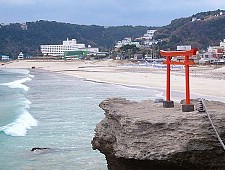 |
| Izu Peninsula |
| Shirahama Beach (more details) |
| Shirahama Beach is the most famous of many nice beaches on theIzu Peninsula - many of which are near the peninsula’s southern tip. The white sand beach is about 800 meters long with facilities like showers, changing rooms and toilets and shops nearby. The beach is also known for relatively good surfing conditions. |
|
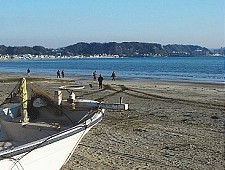 |
| Kamakura |
| Kamakura Beaches (more details) |
| The beaches of Kamakura are about 20 minutes from Kamakura Station by foot. Even though the sand is not white, the beaches are still very popular during the summer months and get crowded with locals and visitors from Tokyo and Yokohama. Rental shops and temporary beach huts open for business during the swimming season, and public facilities include showers and toilets. |
|
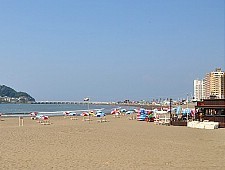 |
| Near Kamakura |
| Enoshima (more details) |
| Beaches line the entire coast to the east and west of Enoshima. Directly next to Enoshima are two popular swimming beaches which are patrolled by lifeguards and are lined by restaurants and temporary beach huts that play popular music and rent deck chairs and parasols to beachgoers during the summer holidays. The beaches further away are also popular surfing spots. Public facilities include toilets and showers, while changing rooms may be available at the beach huts. |
|
Ogasawara Islands
The Ogasawara Islands are a chain of volcanic islands in the Pacific Ocean. The subtropical islands are about 1000 kilometers south of Tokyo, practically in the middle of nowhere, and are only accessible by a 25.5 hour ferry ride from Tokyo. But the isolation is a boon for those looking to get away, and the islands offer lots of secluded beaches with snorkeling and swimming opportunities. Similar to Okinawa, the best time to go swimming here is from around June to October when the temperatures consistently top 25 degrees.
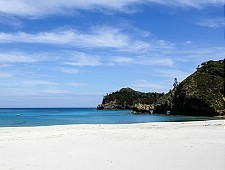 |
| Ogasawara Islands (more details) |
| There are many picturesque white sand beaches on the largest inhabited island, Chichijima, with clear blue water perfect for swimming, snorkeling and sunbathing. Most of the beaches have basic facilities, but some are difficult to get to and have no facilities. The only other inhabited island, Hahajima, is even more remote and offers even more isolated beaches, mostly without facilities. |
|
Other Beaches along the Pacific Ocean
Asides from the beaches around Tokyo, there are many other beaches along the Pacific Ocean coast. Being a long country, temperatures vary widely from one end of Japan to the other. However generally, the swimming season typically takes place around the summer holidays in July and August.
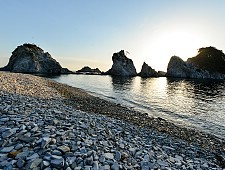 |
| Miyako |
| Jodogahama Beach (more details) |
| Jodogahama Beach is one of the more famous tourist sites along the Sanriku Coast and features interesting rock formations. Popular in the summer, the beach is also ranked as one of the one hundred best beaches of Japan with its clear inlet that is sheltered from the open ocean. Public beach facilities are available. |
|
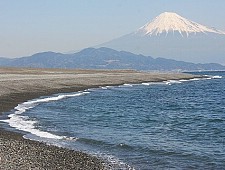 |
| Shizuoka |
| Miho Beach (more details) |
| Miho Beach is best known for its views of Mount Fuji and pine trees. The beach has stones instead of sand, and areas for swimming can be found on the opposite side of the peninsula. Paid facilities at the beach include showers, toilets and changing rooms. |
|
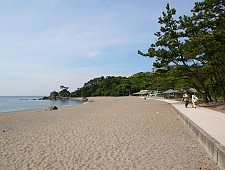 |
| Kochi |
| Katsurahama Beach (more details) |
| Katsurahama Beach is a scenic beach in Kochi. Swimming is prohibited at the beach due to strong currents, but beachgoers can still enjoy sunbathing and sightseeing at the many attractions nearby. |
|
Seto Inland Sea
The Seto Inland Sea lies between the Japanese main islands of Honshu, Shikoku and Kyushu. The islands in the Seto Inland Sea experience a mild climate and some offer beautiful resorts with beaches and other attractions. The swimming season typically lasts from July through September.
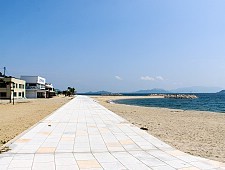 |
| Takamatsu |
| Megijima Island (more details) |
| Megijima Island is a small island off Takamatsu. Its sand beach is not far from the ferry port and attracts many visitors during the summer holidays. Temporary beach huts open for business during the season, and public facilities include paid showers and toilets. |
|
Sea of Japan
The Sea of Japan is decidedly cooler than the Pacific Ocean, but tends to be less developed. Air and water temperatures vary quite a bit from south to north, but swimming can be enjoyed in most places at least from mid July through August. Particularly noteworthy for beachgoers are the rugged Uradome Coast in Tottori Prefecture and the sand beaches of Niigata Prefecture.
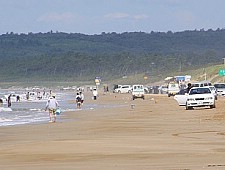 |
| Noto Peninsula |
| Chirihama Beach (more details) |
| Chirihama Beach is a unique beach which is open to private vehicles to drive on. The beach is also popular for swimming, sunbathing and picking shellfish, and temporary beach huts open in the summer. |
|
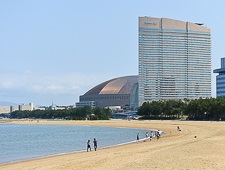 |
| Fukuoka |
| Momochihama Beach (more details) |
| Momochihama Beach is an artificial beach along Hakata Bay at the foot of Fukuoka Tower. There is an artificial island at the center of the beach featuring restaurants, shops and a ferry port with connections across Hakata Bay. The beach is a popular spot for sports such as volleyball and soccer in addition to swimming and sunbathing. Public facilities include showers, changing rooms and toilets. |
|
http://www.japan-guide.com/e/e2461.htmlから取られた材料












